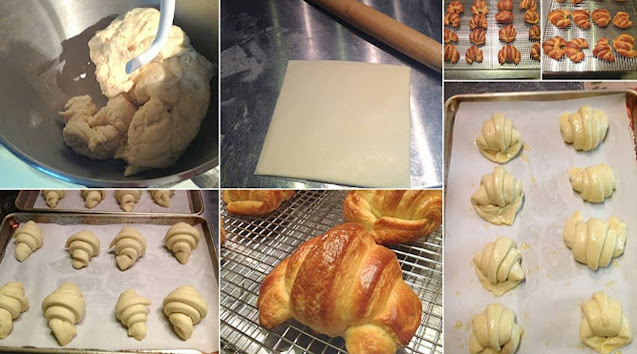Croissants to me are the most decadent of morning pastries. In my mind I drift back to walking in the 5th arrondisiment on the rue Mouffetard and discovering L’essentiel Mouffetard and their most delectable croissants au beurre (butter croissants). This recipe is a reworked version of Julia Childs and others I have worked with over the years.
Croissants are a labor of love. I’ve listed a recipe for 24—do yourself a favour, take half and freeze it for a later date.
Makes about 12- make the full recipe and freeze the second half
1 ounce/3 tablespoons/30g SAF brand instant yeast (I prefer fresh yeast)
1/2 cup/125ml warm water
17.6 ounces/4 cups/500g all purpose flour ( I prefer a mixture of 1 part unbleached AP to 2 parts unbleached Pastry flour for a less glutenous dough)
2-4 tablespoons neutral flavoured oil (optional)
1.3 ounces/3 tablespoons/36g granulated sugar, divided
2 teaspoons/10ml salt
1 cup/250ml milk
for the butter
2 sticks/277g unsalted butter cut into 1/2 inch/1.27cm squares
2 tablespoons/30ml AP flour
1 large egg for brushing
Prove the yeast by pouring warm water into your stand mixter with the yeast, 1 tablespoon/12g sugar, and 1/2 teaspoon/2ml salt. It should foam in 3-5 minutes. Put the flour, oil, sugar, and salt into the bowl of a stand mixer fitted with a dough hook. With the machine on low slowly pour in the milk . Mix for 1 to 2 minutes, until a soft, moist dough forms on the hook. If the dough is to dry, add more milk, 1 tablespoon at a time. Stop the mixer and look into the bowl. All the flour should be incorporated. Set the mixer to its highest speed and work the dough until it is smooth about 4 minutes. Remove the dough from the mixer, wrap it in plastic and put it in a plastic bag, leaving a little room for expansion. Keep the dough at room temperature for 30 minutes to give the gluten time to relax; then refrigerate the dough for 8 hours or overnight.
Attach the paddle attachment to your mixer. Add the cold butter and flour,beat the butter and flour first on low then on the highest speed until smooth and the same consistency as the croissant dough, about 2 minutes. Reach into the bowl and poke around in the butter to make sure that its evenly blended-if you find any lumps, just squeeze them between your fingers. Scrape the butter onto a large piece of plastic wrap and give it a few slaps to knock the air out of it. Mold it into an oval 6 x 1 inch 15.24 x 2.5 cm round or rectangle. Wrap it tightly and refrigerate until needed.
Adding the butter to the dough:
Place the croissant dough on a generously floured large work surface cold(marble is ideal and sprinkle the top of the dough lightly with flour. Using a long rolling pin, roll the dough into an oval approximately 10 inches/25.4 cm wide and 17 inches/43cm long. Brush the excess flour from the dough. Center the chilled butter across the dough and fold the top an bottom of the dough over the butter to make a tidy package. Gently and evenly stretch the folded layers of dough out to ther sides and press the edges down firmly with your
fingertips to create a neatly sealed rectangle. If you own a French rolling pin (one without handles)now’s the time to use it. Hold one side of the dough steady with your hand and strike the other side gently but firmly with the rolling pin to distribute the butter evenly. As you hit the dough you will see the butter moving out into the crevises. After pounding you should have a 1 inch/2.5cm thick rectangle about about 14 inches/35.5cm long and 6 inches/15.25cm wide. Keeping the work surface and the top of the dough well floured, roll out the dough. Now we are going to fold this like a business letter into thirds. Take the top part and fold it 1/2 of the way down then fold the bottom over the folded top portion. You should have three (3) layers. That is your first “turn”. Now roll the dough back out into a 14 inches/35.5cm long and 6 inches/15.25cm wide rectangle. Repeat the folding into thirds (2nd turn), cover it with plastic and chill it for 1 to 2 hours; this way you won’t risk having the dough go soft or the butter seep out. (Each time you wrap the dough, make sure it’s well covered-even a little air will cause the dought to form an unwanted skin.)
Create note with 1st, 2nd, and 3rd turns, and check off the 1st turn. If using a silicone mat, shake off the flour and refrigerate again to chill.
Remove the dough from the refrigerator and allow to rest at room temperature for about 5 minutes. Line your rolling surface with parchment paper or a silicone mat. Again, be sure to dust your rolling surface well. With the longest side facing you, roll the dough out to a 24 x 14 inches/61 x 35.5cm. Repeat the folding as you did for the first and second turns. Roll out again to a 14 inches/35.5cm long and 6 inches/15.25cm wide rectangle. Repeat rolling and folding again for the fourth time. This time fold the long ends until just before they meet in the center of the dough. Fold the two sides like you are closing a book (you should have four (4) layers. Refrigerate for at least 2 hours and check off “2nd turn” on the note you created. For the third turn: Start agian with a 14 inch side running from your left side ti your right. Roll the dough into a rectangle 24 x 14 inches/61 x 35.5cm wide. Fold the left and right sides of the dough into the center, leaving a little space in the centrer, and then fold one side over the other as though you were closing a book. This is the famous double turn, also known as “the wallet”. Chilling the dough: Brush off the flour, wrap the dough in plastic and refrigerate for 2 hours. At this point you can divide the dough in half, wrap tightly and freeze for up to 1 month.
Rolling out your croissants:
Line one or two large baking sheets with parchment paper or silicone baking sheets, depending if you using half or the full recipe. On a well floured rolling surface roll out your dough to about 24 x 14 inches/61 x 35.5cm. If you desire, you can trim any uneven pieces off. Wrap any scraps in plastic wrap or store in a ziplock bag and refrigerate them. You will be using them later. Working with a pizza cutter or a large, very sharp knife, cut triangles from the dough. This is done most easily by making a diagonal cut on the left hand side to geet the pattern started; save the uneven piece of dough. Measure off a 4 inch/10cm base and begin
cutting the triangles, always cutting from bottom to top. You’ll have another scrap when you reach the other end-you’ll use these scraps when you shape the croissants. Unfold each pair of triangles and cut them in half to seperate. You should have 10 to 12 maybe 14 triangles; set them aside while you clear the work surface of all flour. Line two large baking sheets with parchment paper.
Shaping the croissants:
Moisten your hands with a wet towel. Working with one triangle at a time, gently stretch the base to widen it slightly, then, holding the base of the triangle in one hand, run the fingers of the other hand down to the point of the triangle. Use your thumb to pull and stretch the dough until it’s almos twice the original length-have courage and tug; the extra length is what allows you to make a large croissant with sufficient rolls to show off it’s layers of dough. Place the treiangle, point toward you, at arm distance on the work table this will give enough space to roll the croissant into shape with-out having to lift it in mid-roll) Pull off a little piece of the reserved scrap dough, mold it into a small football shape and center it on the wide top part of the triangle-this will help make the “belly” of the croissant plump. Fold about 1/2 inch/1.25cm of this wide end over itself and press the ends down once to secure. With you palms and fingers positioned over the flattened ends of the croissant and the heels of your hands on the flat work surface, roll the croissant toward you-try to keep your hands moving down and out to the sides as you roll- ending with the point of the triangle tucked under the croissant. A well shaped croissant-and it takes practice to achieve one-will sport at least six clearly accountable sections, or ridges, from rolling. Place the croissants on one of the baking sheets, leaving room for them to triple in size without touching one another. Repeat with the other half of the dough.
Glazing and Rising:
Give the croiossants a last gentle plumping, carefully turning the ends down and toward the center to produce the classic croissant shape. Brush the croissants with egg wash and allow them to rise, uncovered, at room temperature for 3 to 4 hours, until
tripled in size and spongy. (Reserve egg wash, covered in the refrigerator.) The ideal place for rising is a turned off oven (one with a pilot light is fine) containing a pan of hot steamy water. To test that they are properly risen, wet your fingers and squeeze the end of a
croissant:It should offer no resistance and feel almost hollow.
Preheat oven to 350F/176C/Gas Mark 4
Brush the croissants once again with egg wash and bake for 12 minutes. Rotate front to back and bake another 4 to 6 minutes, until the croissants are deeply bronzed. Cool on racks.



0 Comments